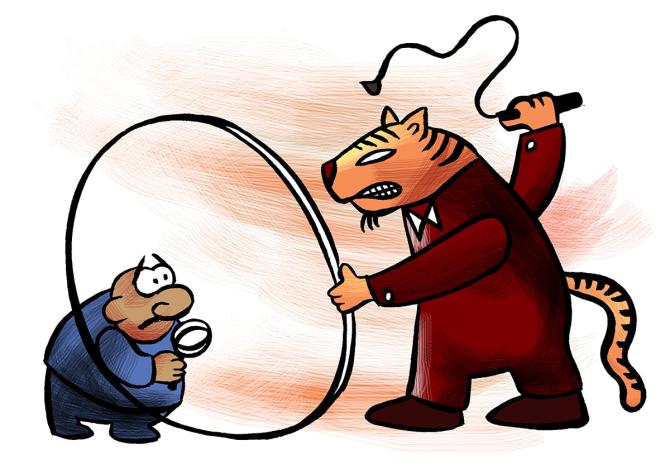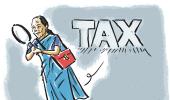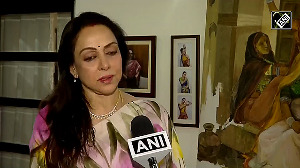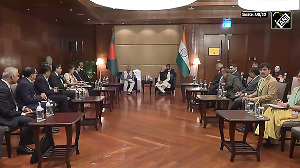Over the past decade, rapid structural changes in the economy have radically altered what was once a low-profile department. With the private sector playing an expanding role in public service delivery, it’s going to be a testing time for the CAG.
Subhomoy Bhattacharjee reports.

In a first, the Comptroller and Auditor General’s (CAG) officers reached out to several ministries in the last week of April as part of a confidence-boosting measure.
The meeting brought the CAG officials and those from the ministries across the table to discuss the pain points in their relations.
CAG of India Girish Chandra Murmu took this novel step because of growing tensions between those audited and the auditor.
As Prime Minister Narendra Modi pointed out last year, “‘CAG versus Government’ has become a common thought in our system.”
By any reckoning, it has been a tumultuous ride since 2011 for a government agency that was once known for its low profile.
CAGs get a six-year term, double the usual three-year term for most other regulators.
In this last decade, each CAG of India has left a major impression.
Vinod Rai served a full six-year term, followed by S K Sharma with four years and then Rajiv Mehrishi for three years.
“Individuals do tend to impact institutions disproportionately in India,” said Mohan Kumar, dean of public policy at OP Jindal Global University, and chairman of Research and Information System for Developing Countries (RIS), a Delhi-based think tank.
“ust as T N Seshan impacted the Election Commission, the past few chiefs of CAG have also done so,” he added.
Part of the reason is that the institution is evolving along with the structural changes in the Indian economy.
“The demands on the auditors have risen sharply as the economy has diversified, and have had an impact on the functioning of the CAG,” said Chakshu Roy, head of outreach, PRS Legislative Research.
The CAG conducts three types of audit — compliance, accounts and performance.
The first two are straightforward. It is the last one that throws up surprises.
A performance audit measures whether a government organisation, a scheme or a project worked within the principles of economy, efficiency and effectiveness.
For example, it would examine whether the purchase of aircraft for Air India, when it was a state-owned airline, was an effective decision or whether the allocation of coal mines to private companies raise coal production and at what cost.
Each year the audit department selects some public sector undertakings, systems, operations, programmes, activities or organisations on which to conduct a performance audit.
The choice is sometimes guided by media noise about them.
The pitfall, as Mehrishi pointed out in a recent seminar organised by the Centre for Social and Economic Progress with the World Bank, is that “the CAG’s audits are only pilot kind of audits.
"If (the selected) department chooses not to give us those files or not give the information, then there is nothing much we can do about it.”
Notwithstanding the limitations, in Rai’s term (2008-2013) the CAG began a new practice of providing an aggregate “loss to the government” in the performance audit reports.
In earlier eras, each deficiency in performance would be summarised as an independent audit para.
Under Rai the audit teams began to add up those numbers. The results were explosive.
What came to be known as coal, telecom or Commonwealth Games scams in public parlance was often the result of this math.
As a result, the audit reports acquired a life of their own.
Rai’s successor Sharma upgraded the department’s information technology systems.
With this backbone, the CAG was able to venture into audits of e-auction of coal mines, the turnaround plan and financial restructuring of Air India, revenue share agreements of telecom service providers, and the pricing mechanism of major petroleum products and hydrocarbon production-sharing contracts.
But Sharma hit the front page when he told a wire agency that the CAG planned to audit the tax implications of demonetisation.
Nothing has been heard on this since.
The former CAG has also faced problems, unrelated to his term as CAG, from his term as defence secretary.
It is about Sharma’s role in India’s procurement of AgustaWestland helicopters under the United Progressive Alliance, in which middlemen were allegedly involved.
The next CAG, Rajiv Mehrishi, reasoned that all audits of a department should be handled by the same team to extract more juice from the inspection.
Accordingly, cutting across audit teams, he has superimposed subject specialisations.
His term was famous for placing a redacted version of the audit of the Rafale aircraft purchase deal - the first time the auditor had placed such a version with Parliament.
Mehrishi also made news for slowing down the number of audit reports issued by his office (see table).
Insiders claim that the slower speed led to greater depth in the audit process.
Mehrishi introduced a new element in his examination of state government accounts.
At the end of the mandatory and formal certificate that accompanies each CAG report, he introduced a section titled “Emphasis of Matter”.
In this paragraph, the supreme auditor listed the key discrepancy in the accounts of the state government that had escaped the state legislatures’ attention.
For FY18 and FY19, there was an unexplained excess or savings in various state government accounts of Rs 2.55 trillion.
Mehrishi also made news by expanding the auditor’s remit.
CAG reports are tabled in Parliament where the committee on public accounts examines them.
In April 2020, the former CAG submitted a report under Article 150 of the Constitution to the President, protesting against “a nightmare of accounts that militates against good governance”.
His detailed note suggested that there should be a 100 per cent data capture of all government earnings and spending, “which is end-to-end— from the time of budgeting to the time of actually invoicing and spending the money”.
He later clarified that his comments were made in the context of the 15th Finance Commission’s report.
Murmu, meanwhile, has turned the spotlight on the third tier of government.
On his watch the national auditor has done the first detailed audits of local government agencies, including hospitals and educational bodies.
To assure ministries and departments that audit will be more of a two-way process, he has revived the standing audit committees in the ministries to address audit queries.
With the private sector playing an expanding role in public service delivery, it’s going to be a testing time for the CAG.













 © 2025
© 2025